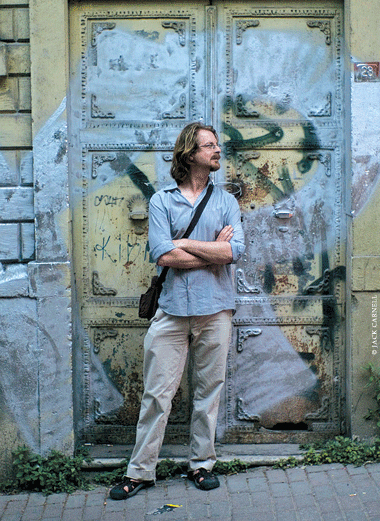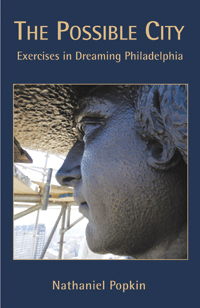
Class of ’91 | “In Philadelphia, imagining a new city is a singular act of citizenship,” writes Nathaniel Popkin C’91 GCP’95 in the introduction to The Possible City: Exercises in Dreaming Philadelphia (Camino Books, 2008). The city’s inhabitants, he notes, live with the double vision of what Philadelphia currently lacks in comparison to other cities—what isn’t—and its rich history of “political, economic, and industrial prominence”—what was. “We dream so intensely because a more satisfying city feels so tantalizingly close.”
Popkin’s view of the urban trajectory in the 20th century was shaped by his childhood in Trenton, New Jersey, in which contemporary decline was contrasted with the glowing memories, passed down by older relatives, of its heyday as “the quintessential middle-class city.” As an undergraduate, “the great joy of Penn was the city and just going and walking around,” Popkin says. That pleasurable perambulating, combined with a freshman seminar taught by Ted Hershberg, professor of public policy and history and director of Penn’s Center for Greater Philadelphia, “put my mind into thinking about the city.”
After earning his master’s in city planning, Popkin worked with the Center for Community Partnerships—where one of his projects was to develop the Spruce Hill Neighborhood Plan—and with the West Philadelphia Enterprise Center. These days he thinks of himself as more of a writer than a traditional city planner. He published his first book, Song of the City: An Intimate History of the American Urban Landscape, in 2002 [“Alumni Profiles,” Jan|Feb 2003], and has published essays and articles on city life, the environment, and Philadelphia, for a variety of print and online media. He’s currently writer-in-residence at Philadelphia University.
It’s clear that Popkin is intimately familiar with the range of writings on urbanism, not to mention Philadelphia history. The book is also studded with literary references (the Turkish novelist and memoirist Orhan Pamuk is a particular favorite). But much of The Possible City is built around direct observation, as Popkin visits various city locales and engages locals from the Wissahickon Creek to Kensington.
“I do it that way because that is what I love,” he says. “And I happen to be lucky in that I get to write about, think about, and imagine what interests me. I love to talk to people; Philadelphians love to talk. They are very open and they are very interested and observant about their own world and think about their city—what it was and what it might be. It’s almost an obsession.”
Popkin shares that obsession—sometimes, he admits, to excess: “It’s Philadelphia, and one can’t help but think what might be—because it is the city that isn’t, you know? It’s the city of vast potential.”
Philadelphia’s decline is a familiar story of loss—of industry, population, tax revenues—writ large because of how far the city had to fall from its peak of influence, along with a perverse, proud defensiveness on the part of leaders and residents alike. In 1900, Philadelphia was the world’s 10th largest city, but since 1950 its population has declined by a quarter. For at least the last half-century, when the “post-industrial” period began, Philadelphia “has been searching for a reason to be,” Popkin writes in the book. “We’re still searching, our dreams hindered—but also fed—by the ruins of a more populous place.”
“Here was a manufacturing city, and it all of a sudden had to become a different kind of city,” he explains. “Maybe the high point of industrialization was the 1920s. Well, thanks to World War II, we had this other peak, and so we were able to convince ourselves that [Philadelphia was] still an industrial powerhouse. And it’s been so slow and so diffuse in terms of industry—we’re always panoptic in everything in Philadelphia, never one thing—that it’s taken us longer, I think, than certain other places to adjust.”
Another key theme in the book is a distinction between cities that merely function and those that perform. It’s a critical element in Popkin’s vision of the urban future, and one that he borrowed from architect Winka Dubbeldam, practice professor of architecture at the School of Design, who uses it to differentiate contemporary architecture from modernism.
“Modernism is concerned with form following function,” Popkin explains. “You can see visually, you can feel as the user of a building, how that works. You understood what each part of the building did.
“Nowadays we like to integrate everything. We’re supposed to be having this interview while you’re texting someone,” he adds. “Buildings are supposed to do all that, too, and I think [Dubbeldam] gets that. It’s got to perform. I sort of extend the performance notion to something that’s more traditional. And I think we’re seeing this, all over the world.”
As an example, Popkin cites designer Thomas Heatherwick’s Rolling Bridge at London’s Paddington Station, which is both a functional drawbridge and a piece of sculpture, basically rolling up into a ball to allow boat traffic to pass. “And it’s so good that people come [just to see it],” he says, “At 12:00 every day they have a public viewing period. That’s exciting. We need this sense of magic.”
For a local example of performance failure, Popkin points to the absence of a bus shelter at a certain stop on Philadelphia University’s campus, which caused him to get soaked one day. The Possible City is “not just about Philadelphia,” he says. “The Cincinnatis, Richmonds, Albanys, St. Louises, are all doing what we’re doing right now. They’ve felt a little optimism in this last period because things were getting built. People were valuing the cities in ways that they hadn’t done in a while.”
Though the current economy will likely put many urban projects on hold, some positive trends should continue, including urban farming and farmer’s markets and the movement toward environmentally sustainable economies—which cities, with their high population density, walkable destinations, and available public transportation, foster.
Furthermore, the swelling numbers of Americans who travel to cities in Asia, Europe, and Latin America have also returned with higher expectations for their own urban environments. “They’re saying, ‘Well, why don’t we have that?’” Popkin notes. “And then they’re inventing [answers] in their own cities.”
—J.P.
EXCERPT
And So We Dream …

City Hall sits on the fifth of William Penn’s five original squares, still considered Centre—or Penn—Square. It remains the center of three branches of municipal government. Inside are court records, deeds, courtrooms, the offices of the mayor and representatives of city council, the chambers of judges, grand halls, portraits, hundreds of sculptures and friezes, and a courtyard that looks like a palace but feels like a bus station.
Centre Square is the southeastern axis of the Benjamin Franklin Parkway, a Beaux Arts boulevard meant to mimic the passage between the Louvre and the Arc de Triomphe in Paris. At the northwest axis stands the Philadelphia Museum of Art. In between, at Logan Square, is a Philadelphia Place de la Concorde. The library and courthouse there replicate the Hotel de Crillon and the building that houses the U.S. Embassy. But Paris, sadly, this is not. The vast plaza outside of City Hall, above and below ground, connecting to the city’s most important transit hub, and facing the art museum, is empty. There are statues, lamps, and last year, even a public toilet.
And so we dream, of ice skating rinks and lawns and movie screens and cafe tables and jugglers and artists and sculpture competitions and mini-museums and cooking demonstrations and gardening workshops; we dream of ice cream stands and vendors’ carts and lunchtime dining and wine bars and free speech zones; we dream, as Mayor Nutter has, of farm stands, of tables upon tables upon tables punctured by a giant sculptural Philadelphia stoop, where under the shade of a Franklin tree it might be possible to dream away an afternoon. (Benjamin Franklin deserves a place here because it was his persistence at the French court that produced the money for the American Revolution, bankrupted the French monarchy, causing the French Revolution, and ultimately putting the Tuilleries and the New Louvre, the buildings from which City Hall was derived, in the hands of the people.)
These City Hall visions join our other, endless Philadelphia dreams: of uncovering lost streams, of building green roofs, of recreating remembered homelands, of diagonal subway lines, of bike sharing, of skateboard parks, of museums for art and immigrants and food, of literary events, of movie theaters, of drawbridges, of promenades, of wild ruins left to rot, of 1,500-foot skyscrapers, of restored trolley cars, of restored railroad stations, of train lines long defunct, of public climbing walls, of marinas, of street performers, of ice cream stands, of balloon men, of championship parades, of clean streets, of the political and economic reality it will take to make the dreams reality.
Excerpted with permission from The Possible City: Exercises in Dreaming Philadelphia, copyright © 2008 by Nathaniel Popkin, published by Camino Books, Inc., Philadelphia (www.caminobooks.com).




